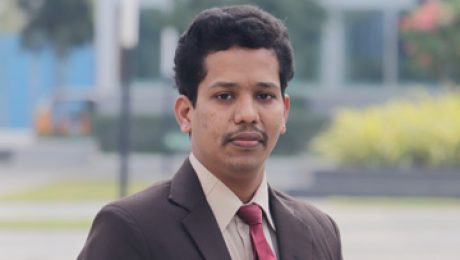SRM AP welcomes Prof Shobhana Narasimhan as the resource person in the webinar “EFFECTIVE WAYS OF WRITING RESEARCH ARTICLE”
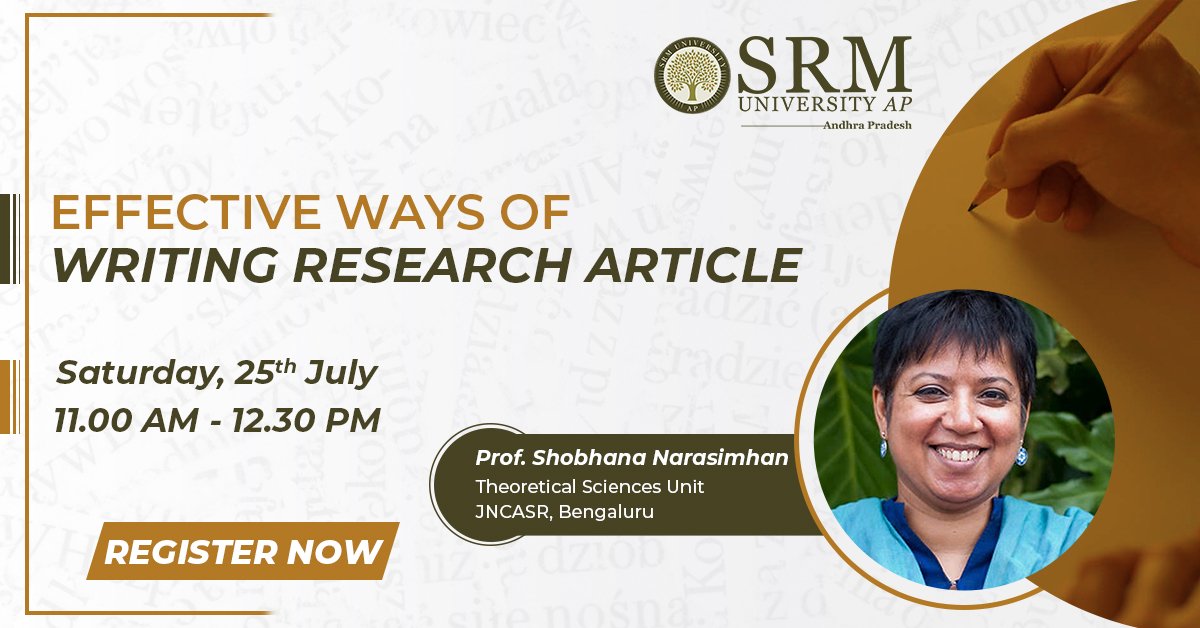 SRM University-AP, Andhra Pradesh is organizing a webinar titled “EFFECTIVE WAYS OF WRITING RESEARCH ARTICLE” on 25th July from 11.00 AM till 12.30 PM. Writing a research paper is a great opportunity for young students to explore ideas that are relevant and socially beneficial. Being effectively able to write a research paper enables scholars to demonstrate their expertise on the domain, and the writing process helps in enhancing the critical analyzing skills of Ph.D students, and the young faculty members.
SRM University-AP, Andhra Pradesh is organizing a webinar titled “EFFECTIVE WAYS OF WRITING RESEARCH ARTICLE” on 25th July from 11.00 AM till 12.30 PM. Writing a research paper is a great opportunity for young students to explore ideas that are relevant and socially beneficial. Being effectively able to write a research paper enables scholars to demonstrate their expertise on the domain, and the writing process helps in enhancing the critical analyzing skills of Ph.D students, and the young faculty members.
Prof Shobhana Narasimhan from Jawaharlal Nehru Centre for Advanced Scientific Research (JNCASR), Bengaluru will be delivering a talk as the resource person. She is a highly reputed theoretical Physicist and has a great passion for ‘writing of Research Articles’. Prof Shobhana did her MSc in physics from IIT Bombay, and her Ph.D. from Harvard University. Since 1996 she has been the faculty of the Jawaharlal Nehru Center for Advanced Scientific Research, Bengaluru, where she is a Professor in the Theoretical Sciences Unit.
Registration Link: Please Click Here
THE NEWS-MAKERS: Dr. Tousif joins an interactive session with the participants
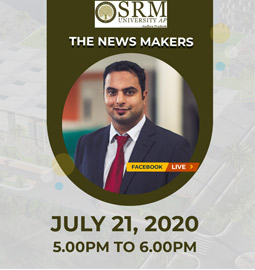 The Department of Student Affairs brings another exciting session of THE NEWSMAKERS today. Dr Tousif Khan N, who was very recently honoured with APJ Abdul Kalam Memorial International Travel Award for his remarkable research on “Online adaptive fast output voltage tracking in DC power supply system”, will be joining the participants to share his research experience with them. Dr Khan is the Assistant Professor and Head of the Department of Electronics and Electrical Engineering and internationally acclaimed for his impactful research. Join Dr Khan on July 21st 2020, between 5.00 to 6.00 pm to know more from the man himself.
The Department of Student Affairs brings another exciting session of THE NEWSMAKERS today. Dr Tousif Khan N, who was very recently honoured with APJ Abdul Kalam Memorial International Travel Award for his remarkable research on “Online adaptive fast output voltage tracking in DC power supply system”, will be joining the participants to share his research experience with them. Dr Khan is the Assistant Professor and Head of the Department of Electronics and Electrical Engineering and internationally acclaimed for his impactful research. Join Dr Khan on July 21st 2020, between 5.00 to 6.00 pm to know more from the man himself.
To watch the session live on our official Facebook page, stay tuned on – https://www.facebook.com/SRMUniversityAmaravati/
SRM AP faculty receives the prestigious grant by DBT/Wellcome Trust India Alliance
Investigating giant bacterial viruses to explore the origin of cellular complexity
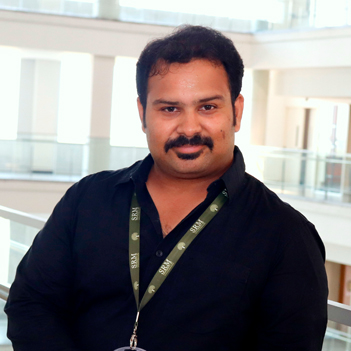 Dr. Sutharsan Govindarajan, Assistant Professor, Department of Biological Sciences, SRM University-AP has been awarded the prestigious ‘Early Career Fellowship’ grant by DBT/Wellcome Trust India Alliance, funded by the Department of Biotechnology (DBT) and the Wellcome Trust, United Kingdom. The fellowship supports outstanding young scientists to pursue high-quality research in the field of biomedical science and establish themselves as independent researchers in India. Dr. Sutharsan sought a total research grant of 1.1 crore for a period of 5 years as a DBT/Wellcome Trust India Alliance Early career fellow. The India Alliance grants are highly competitive and is based on the profile of the applicant and the novelty and the importance of the proposed research. Nationwide only less than 10 Early Career grants are awarded every year. Dr Sutharsan is a highly accomplished scientist, having published research articles in highly reputed journals, including the most prestigious Nature and Nature Microbiology. Through this fellowship, Dr. Sutharsan will establish an independent research laboratory at SRM University – AP with the support of Prof. Jayaseelan, Head, Department of Biological Sciences, and the fellowship supervisor of the project.
Dr. Sutharsan Govindarajan, Assistant Professor, Department of Biological Sciences, SRM University-AP has been awarded the prestigious ‘Early Career Fellowship’ grant by DBT/Wellcome Trust India Alliance, funded by the Department of Biotechnology (DBT) and the Wellcome Trust, United Kingdom. The fellowship supports outstanding young scientists to pursue high-quality research in the field of biomedical science and establish themselves as independent researchers in India. Dr. Sutharsan sought a total research grant of 1.1 crore for a period of 5 years as a DBT/Wellcome Trust India Alliance Early career fellow. The India Alliance grants are highly competitive and is based on the profile of the applicant and the novelty and the importance of the proposed research. Nationwide only less than 10 Early Career grants are awarded every year. Dr Sutharsan is a highly accomplished scientist, having published research articles in highly reputed journals, including the most prestigious Nature and Nature Microbiology. Through this fellowship, Dr. Sutharsan will establish an independent research laboratory at SRM University – AP with the support of Prof. Jayaseelan, Head, Department of Biological Sciences, and the fellowship supervisor of the project.
In this project, Dr. Sutharsan plans to venture and explore the biology of a novel class of bacteriophages called Jumbo-phages. “Bacteriophages, which are the most abundant biological entities on the planet, are viruses that infect bacteria but do not harm humans. Jumbo-phages, as the name suggests, are giant viruses with large genome. A sneak peek into their lifestyle during my postdoctoral research led me, to realize that these phages build fascinating complex structures inside the bacteria they infect. Such complex structures are well known to be formed in eukaryotic cells like human cells but was not thought to be made by bacteriophages, which have evolved billions of years before eukaryotes. Thus, studying how such cellular structures are formed by jumbo-phages provides a unique opportunity to investigate the origin of complex life” informs Dr. Sutharsan. He also explains that the proposed research has several biotechnological applications such as phage therapy and synthetic biology.
Dr. Sutharsan further shares, “This is one the best fellowships, a young scientist can obtain in India. It is an honour, prestige and a recognition for the scientist as well as to the University. In the next 5 years, I anticipate major fundamental discoveries in the field of bacteriophage biology and evolution”.
- Published in News, Research News
Department of Student Affairs organizes “My Corner”
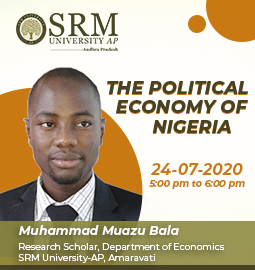 Department of Student Affairs, SRM University-AP, Andhra Pradesh organizes the webinar “My Corner”. During this session, Muhammad Muazu Bala, Research Scholar, Department of Economics, SRM University-AP, Andhra Pradesh will deliver a talk as the resource person on the” Political Economy of Nigeria”. Tune in on 24th July 2020 at 5. p.m. for an interactive and illuminative session.
Department of Student Affairs, SRM University-AP, Andhra Pradesh organizes the webinar “My Corner”. During this session, Muhammad Muazu Bala, Research Scholar, Department of Economics, SRM University-AP, Andhra Pradesh will deliver a talk as the resource person on the” Political Economy of Nigeria”. Tune in on 24th July 2020 at 5. p.m. for an interactive and illuminative session.
Session Link: Please Click Here
Department of Student Affairs organizes an engaging session on “E-mail Etiquette”
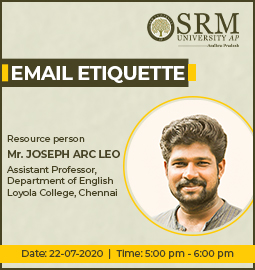 How to write a perfect e-mail? How to choose the salutation and subject line? How to begin and end the e-mail? These questions have bothered individuals at some point in their life. Needless to say, E-mail etiquette are now an essential part of professional grooming, and it is as important as your social etiquette. Get all your queries answered in this engaging session with Mr JOSEPH ARC LEO. Mr Leo is an Assistant Professor in the Department of English, Loyola College, Chennai. He will be joining us today, 22nd July at 5 pm to discuss proper e-mail etiquette that are to be followed. Registrar yourself quickly to avail the opportunity.
How to write a perfect e-mail? How to choose the salutation and subject line? How to begin and end the e-mail? These questions have bothered individuals at some point in their life. Needless to say, E-mail etiquette are now an essential part of professional grooming, and it is as important as your social etiquette. Get all your queries answered in this engaging session with Mr JOSEPH ARC LEO. Mr Leo is an Assistant Professor in the Department of English, Loyola College, Chennai. He will be joining us today, 22nd July at 5 pm to discuss proper e-mail etiquette that are to be followed. Registrar yourself quickly to avail the opportunity.
Workshop on “Artificial Intelligence (AI) for Healthcare” in collaboration with IEEE-SRM AP Student Branch
Department of Electronics and Communication Engineering, SRM University-AP, Andhra Pradesh organizes workshop on “Artificial Intelligence (AI) for Healthcare” in collaboration with IEEE-SRM AP Student Branch. Prof. D. Narayana Rao, Pro Vice-Chancellor will inaugurate the workshop on 25th July, 2020 at 9:30 am with the opening remarks. Dr. Muralikrishna Voonna, Managing Director, Mahatma Gandhi Cancer Hospital & Research Institute will deliver a Guest Lecture on “Impact of AI in Clinical Healthcare”. Further, during the session, Guest Lecturer, Dr. Rajiv Janardhanan, Director, Amity Institute of Public Health, Professor ACVB will be speaking on “Sustainable Healthcare: AI enabled platforms for Affordable and Accessible Healthcare Solutions”.
Eminent panelists such as Padma Shree Awardee – Prof. Upendra Kaul, Dr. Pooja Ramakant, Dr. Sunil Taneja, Dr. Muralikrishna Voonna, and Dr. Rajiv Janardhanan will be interacting on “Impact of Covid-19, AI on Healthcare”. Prof. Priya Ranjan, Department of ECE , SRM AP will be moderating the session during the workshop. Attend this insightful event to understand the approach in which AI is reinventing and improving the modern healthcare through technologies that can estimate, comprehend, explore, and perform effectively.
Brochure: Download Here
Registration Link: Please Click Here
- Published in ECE Events, Events, Research Events, Research Workshop, Workshop
Campus Placements 2020-2021
12 brilliant students of SRM AP lands up with excellent job offers to initiate the Campus Recruitment Drive
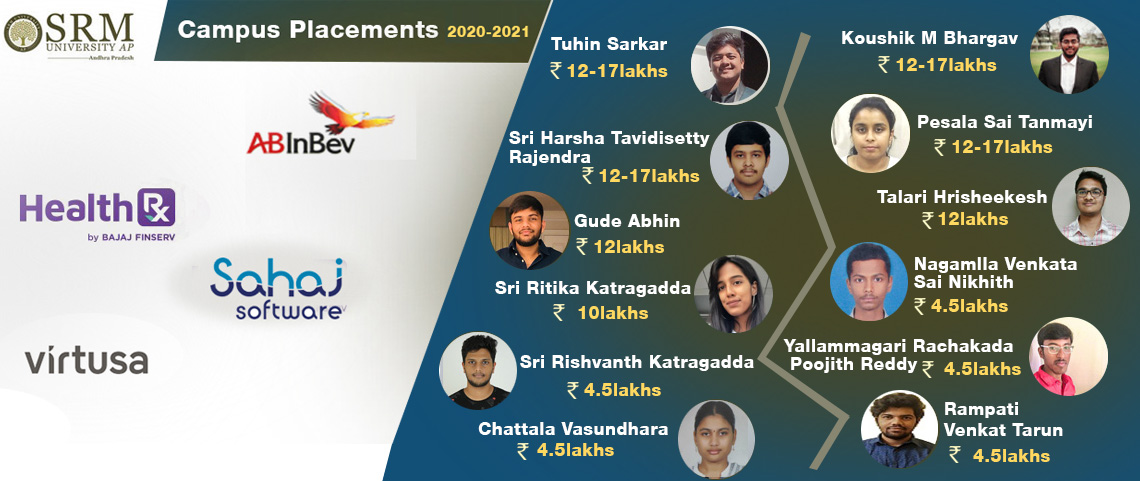
SRM University-AP, Andhra Pradesh has commenced its journey to secure a better future for the first batch of students. Promising students of SRM AP have grabbed excellent job offers in the Campus Recruitment Drive for Class 2021 B.Tech students. Anheuser-Busch InBev offered 6 months internship, followed by a job offer to outstanding candidates. The company shortlisted Pesala Sai Tanmayi, Sri Harsha Tavidisetty Rajendra, Tuhin Sarkar, and Koushik M Bhargav. Anheuser -Busch InBev SA/NV, commonly known as AB InBev is a Belgian multinational drink and brewing company. The company has offered an internship stipend of 30 thousand per month and a CTC of 12-17 LPA to the candidates who will join the company after successful completion of their internship.
Another renowned company Health Rx, which innovates and develops secure web-based and mobile solutions to streamline information flow in the clinical and research environments, has offered Technical Internship with a stipend of 35 thousand per month, and post that a confirmed job offer with CTC of 12 LPA to Talari Hrisheekesh, and Gude Abhin. Further, VIRTUSA Corporation, an American IT service provider, offered a position in the company with a CTC of 4.5-6.5 LPA to Yallammagari Rachakada Poojith Reddy, Nagamlla Venkata Sai Nikhith, Chattala Vasundhara, Rampati Venkat Tarun, and Sai Rishvanth Katragadda. The other company which conducted the recruitment drive at SRM AP, Sahaj Soft, selected Sri Ritika Katragadda and offered her a CTC of 10 LPA. Sahaj Soft is a software services and consulting firm which provides simple solutions backed by their time-tested methodology and engineering practices.
As the recruiters shortlist the best young talent who are enthusiastic, devoted to learning and brimming with fresh and creative ideas, SRM AP placement team have thoroughly trained the students both in terms of technical expertise and soft skills. The rigorous training that the students underwent since the beginning of their B. Tech course, coupled with their talent and motivation, has enabled them to succeed in recruitment drive with flying colours. SRM AP believes that this is merely the beginning of the placement season, and many more brilliant students are waiting to showcase their mettle to land up with excellent job offers in top-notch companies.
- Published in CR&CS NEWS, News
The Newsmakers: An interview with Dr Somesh on his journey as a researcher
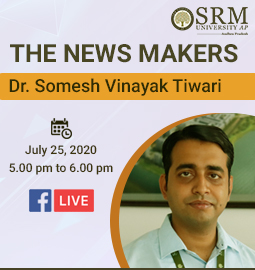 Dr Somesh Vinayak Tiwari, Assistant Professor, Department of Electrical and Electronics Engineering, joins The Newsmakers session on 25th July 2020 at 5 pm. Dr Somesh Vinayak Tiwari was awarded the prestigious “Outstanding Doctoral Students Award”, from Homi Bhabha National Institute (HBNI) at an event held at the Department of Atomic Energy (DAE) Convention Centre, Anushaktinagar, Mumbai. Dr Tewari was presented this award for his excellent PhD thesis titled “Study of surface flashover of insulator in gases at high pressure.” In the session of The Newsmaker, he will be interviewed by Dr Anuj Deshpande, Assistant Professor, Department of Electronics and Communication Engineering, on his journey as a doctoral scholar and researcher.
Dr Somesh Vinayak Tiwari, Assistant Professor, Department of Electrical and Electronics Engineering, joins The Newsmakers session on 25th July 2020 at 5 pm. Dr Somesh Vinayak Tiwari was awarded the prestigious “Outstanding Doctoral Students Award”, from Homi Bhabha National Institute (HBNI) at an event held at the Department of Atomic Energy (DAE) Convention Centre, Anushaktinagar, Mumbai. Dr Tewari was presented this award for his excellent PhD thesis titled “Study of surface flashover of insulator in gases at high pressure.” In the session of The Newsmaker, he will be interviewed by Dr Anuj Deshpande, Assistant Professor, Department of Electronics and Communication Engineering, on his journey as a doctoral scholar and researcher.
Watch the session live on our official Facebook page and avail the opportunity to know more about a doctoral scholar’s life from someone who has recently experienced it.
Energy-Efficiency Optimization over Full-Duplex IoT Networks Towards Commercial Applications
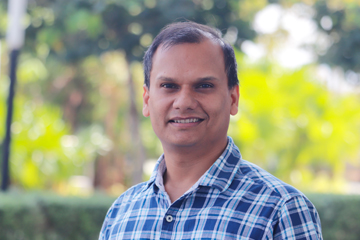 Dr Om Jee Pandey Two research papers of Dr Om Jee Pandey, Assistant Professor, Department of Electronics and Communication Engineering, have been accepted in reputed IEEE Journals. The papers titled “Multiuser Full-Duplex IoT Networks with Wireless-Powered Relaying: Performance Analysis and Energy Efficiency Optimization,” and “Time Synchronized Node Localization Using Optimal H-Node Allocation in a Small World WSN” are going to be published in IEEE Transactions on Green Communications and Networking and IEEE Communications Letters, respectively. The paper “Multiuser Full-Duplex IoT Networks with Wireless-Powered Relaying: Performance Analysis and Energy Efficiency Optimization,” was pursued in collaborations with Prof. Ha H. Nguyen, Department of Electrical and Computer Engineering, University of Saskatchewan, Saskatoon, Canada, and Dr Mahendra K. Shukla, who is associated with Macau University of Science and Technology as a Post Doctoral Fellow.
Dr Om Jee Pandey Two research papers of Dr Om Jee Pandey, Assistant Professor, Department of Electronics and Communication Engineering, have been accepted in reputed IEEE Journals. The papers titled “Multiuser Full-Duplex IoT Networks with Wireless-Powered Relaying: Performance Analysis and Energy Efficiency Optimization,” and “Time Synchronized Node Localization Using Optimal H-Node Allocation in a Small World WSN” are going to be published in IEEE Transactions on Green Communications and Networking and IEEE Communications Letters, respectively. The paper “Multiuser Full-Duplex IoT Networks with Wireless-Powered Relaying: Performance Analysis and Energy Efficiency Optimization,” was pursued in collaborations with Prof. Ha H. Nguyen, Department of Electrical and Computer Engineering, University of Saskatchewan, Saskatoon, Canada, and Dr Mahendra K. Shukla, who is associated with Macau University of Science and Technology as a Post Doctoral Fellow.
 Block diagram of the full-duplex
Block diagram of the full-duplex
wireless-powered relay based on power splitting There has been a growing interest in improving energy efficiency for next-generation Internet of Things (IoT) networks due to the increasing demand for green communications. Motivated by this demand, energy efficiency maximization has been investigated for several networks. Specifically, without considering simultaneous wireless information and power transfer networks, various works have extensively studied energy efficiency maximization for half-duplex networks and full-duplex networks. Further, by considering simultaneous wireless information and power transfer networks, several works have examined energy efficiency maximization in half-duplex networks. Moreover, energy efficiency for next-generation IoT networks with simultaneous wireless information and power transfer has also been studied by considering half-duplex transceivers. It appears that energy efficiency problems for multiuser full-duplex IoT networks have not been studied in the open literature.
 Multiuser FD-IoT network with
Multiuser FD-IoT network with
wireless-powered TWR Motivated by the above discussion, in this work we consider a full-duplex IoT network in which a multi-antenna access point and several single antenna IoT devices exchange information bidirectionally with the aid of a wireless-powered single-antenna relay, under generalized Nakagami-m fading channels. In particular, we consider the power splitting protocol at the full-duplex relay terminal, and each communication terminal operates in the full-duplex mode. For such a network, we first formulate the instantaneous end-to-end signal-to-interference-plus-noise ratios (SINRs) by employing maximum-ratio transmission (MRT) beamforming and maximum-ratio combining (MRC) at the access point A, as well as IoD scheduling. Then, based on the obtained SINRs, we evaluate the overall outage probability and ergodic sum-rate of the network. Furthermore, we develop an optimal power allocation to maximize the network’s EE.
 Integral area for the
Integral area for the
overall outage probability Recently, with many technological advancements in wireless data transmission, IoT is expected to affect all aspects of our daily lives with its ever-growing and emerging applications. Traditional wireless communication networks are usually limited by the operational time of energy-constrained devices, and therefore energy consumption minimization is a crucial factor in IoT networks. Simultaneous wireless information and power transfer have emerged as a sustainable solution to the scenarios where replacing or recharging batteries is very costly, and may even be impossible. The basic idea of simultaneous wireless information and power transfer is that since radio frequency signals can carry information and energy at the same time, the received radio frequency signals can be utilized for energy harvesting to keep the energy-constrained devices operational. Existing studies adopt two different protocols, namely time switching and power switching, to implement simultaneous wireless information and power transfer receiver architecture. With these protocols, either the power or time of the received signal is split so that one part is used for information processing, and the other is used for energy harvesting.
The proposed research can play a crucial role in societal development as it can be applied in developing many state-of-the-art applications in the areas related to green healthcare systems, energy-efficient agriculture systems, green transportation, low power home automation, green manufacturing, low power smart utilities, and energy-efficient industries etc.
His other paper “Time Synchronized Node Localization Using Optimal H-Node Allocation in a Small World WSN”, DOI (identifier) 10.1109/LCOMM.2020.3008086, has been done in collaborations with Prof. Rajesh M Hegde, Department of Electrical Engineering, IIT Kanpur and Dr Mahendra K. Shukla, Post Doctoral Fellow at Macau University of Science and Technology. To know more about Dr Pandey’s work in the domain of Small-World Wireless Sensor Network, visit- https://srmap.edu.in/news/dr-om-jee-pandey-small-world-wireless-sensor-network-help-making-smart-applications-industries/.
Dr Pandey is now not only working for the commercial applications of his current research but also has devoted himself to his future projects, that include-
Full-Duplex Network Development for Green Healthcare Systems.
Energy-Efficient Cyber-Physical Systems and Internet of Things.
Development of Energy-Efficient Agriculture Systems.
Green and Intelligent Transportation over Full-Duplex Context-Aware Pervasive Systems.
- Published in ECE NEWS, Faculty, News, Research News


